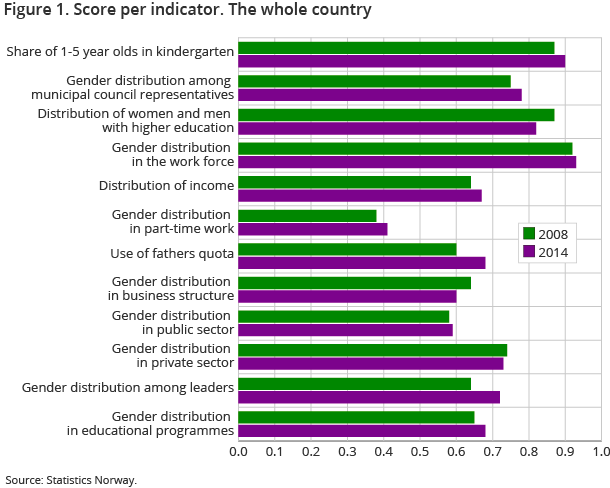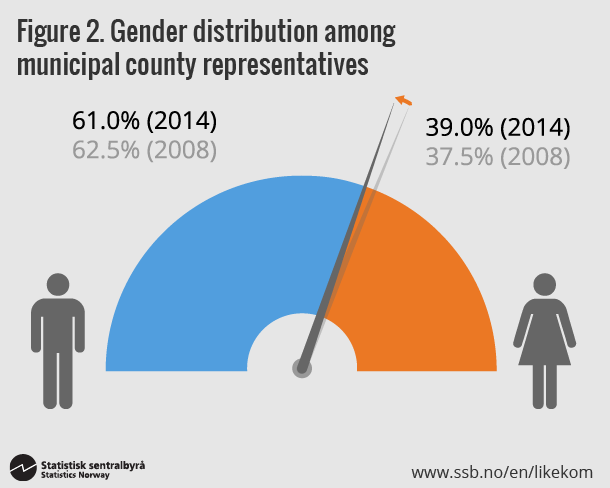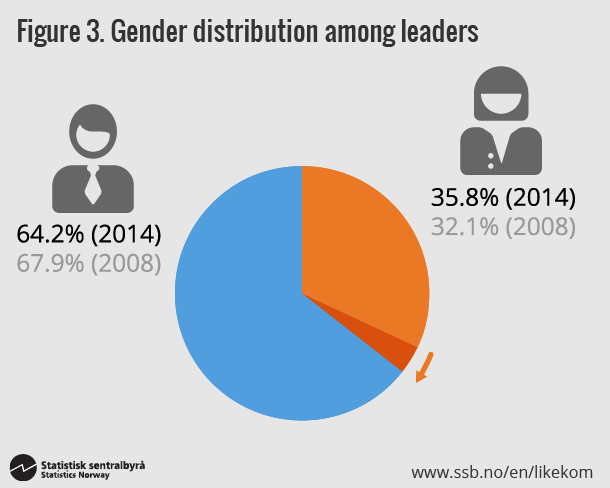Content
Published:
This is an archived release.
Gender inequality is decreasing
In general, the gender gap in Norway is considered to be small. Statistics Norway`s gender equality indicators for Norwegian municipalities in 2014 show that there has been a weak but positive development towards more gender equality since 2008, even in fields where there have traditionally been large gender disparities. The disparities in the proportions of male and female managers, income and part-time work are the lowest since 2008.
| 2013 | 20141 | |
|---|---|---|
| 1The results from the municipal election of 2015 has been used to estimate the score on the indicator "share of men and women among municipal county members". The rest of the indicators are estimated on the basis of statistics from 2014. | ||
| Share of 1-5 years olds in kindergarten (per cent) | 90.0 | 90.2 |
| Share of men among municipal county members (per cent) | 61.8 | 61.0 |
| Share of women among municipal county members (per cent) | 38.2 | 39.0 |
| Share of men with higher education (per cent) | 26.2 | 28.1 |
| Share of women with higher education (per cent) | 32.3 | 34.3 |
| Share of men (20-66 years) in the work force (per cent) | 82.7 | 83.1 |
| Share of women (20-66 years) in the work force (per cent) | 77.1 | 77.6 |
| Average gross income, men (NOK) | 487 800 | 503 600 |
| Average gross income, women (NOK) | 326 400 | 338 900 |
| Share of employed men (20-66 years) working part-time (per cent) | 13.9 | 14.2 |
| Share of employed women (20-66 years) working part-time (per cent) | 34.7 | 34.7 |
| Share of fathers taking the full fathers quota or more (per cent) | 68.5 | 68.2 |
| Level of gender balanced business structure (score) | 0.60 | 0.60 |
| Share of men among employees (20-66 years) in public sector (per cent) | 29.5 | 29.6 |
| Share of women among employees (20-66 years) in public sector (per cent) | 70.5 | 70.4 |
| Share of men among employees (20-66 years) private sector (per cent) | 63.5 | 63.4 |
| Share of women among employees (20-66 years) private sector (per cent) | 36.5 | 36.6 |
| Share of men among leaders (20-66 years) (per cent) | 64.3 | 64.2 |
| Share of women among leaders (20-66 years) (per cent) | 35.7 | 35.8 |
| Level of gender balance in educational programs in upper secondary school (score | 0.67 | 0.68 |



Some prominent tendencies have been observed in Norwegian municipalities ever since Statistics Norway started measuring regional gender equality. Some regions have greater gender equality than others. The municipalities in the regions of Eastern and Northern Norway generally have high scores for most of the gender equality indicators in 2014, while in Southern and South-Eastern Norway a large number of the municipalities have low scores for many of the indicators. However, there are also large variations between the different municipalities within the regions for some of the indicators. The score particularly varies between the municipalities in relation to indicators of gender balance among municipal councillors, in higher education, and in part-time work.
Increase in proportion of female municipal councillors after the election
The score for the indicator that measures gender balance among municipal councillors is at its highest since it was first measured by Statistics Norway. On average, the proportion of female municipal councillors is now 39 per cent for the country in total. This is an increase of 1.5 percentage points increase since the election of 2007. Municipalities in Akershus, Nord-Trøndelag, Buskerud score the highest, with a proportion of 40-45 per cent women among municipal councillors Municipalities in Telemark and Aust-Agder score the lowest, with female councillors making up 35 per cent. In these counties the proportion of female councillors are below 35 percent.
The counties of Nordland and Nord-Trøndelag stand out because of the male council minority they have in many of their municipal councils. Twelve out of 33 municipalities with over 50 per cent female councillors are located in these counties. However, in municipalities where a large majority of the councillors are female, the indicator score is quite low because male councillors are in the minority. However, the proportion of male councillors only falls below 35 per cent in two Norwegian municipalities, while the minority of female councillors is below 35 per cent in about one third of the municipalities.
Male dominance despite more female managers
The score for the indicator that measures the ratio between the proportion of male and female managers has increased significantly since 2008. The proportion of female managers has increased by almost 4 percentage points over the last six years. The biggest increase has been in Østfold, where the share of female managers has increased by almost 5 percentage points. Møre og Romsdal and Oppland, have also seen a significant increase in female managers. Despite the increase in female managers from 2008 to 2014, men still make up the majority of managers in all Norwegian counties. Men hold almost two thirds of all managerial positions in the country as a whole.
Oslo and Finnmark have the highest score for the indicator measuring gender balance in managerial positions. On the other side of the scale, we find Aust-Agder and Vestfold with the lowest scores. Tendencies are identified between different regions when we consider how the different parts of the country score on the indicator for gender balance in managerial positions. Oslo and many of the municipalities in Northern Norway have high scores. Many municipalities in the middle of Norway have an average score, while many municipalities in Southern Norway score quite low.
Women still have a higher educational level than men
The score for the indicator that measures the balance in educational levels between men and women has fallen every year since 2008. In 2014, however, the score has flattened out from the year before. There is, however, still an imbalance between male and female educational levels. An increasingly higher share of women compared to men are attaining a higher education. We find the biggest disparity between male and female educational levels in the county of Finnmark, where the proportion of men with a higher education is 19.5 per cent and the proportion of women is 32 per cent. Finnmark has the lowest score on the indicator. Oslo gets the highest score on the indicator because the proportion of men and women with a higher education is almost equal, with 46 and 49 per cent respectively.
Despite the fact that there has been an increase in the proportion of female municipal councillors and female managers, that women have higher educational levels than men, and that men and women participate in the labour market to almost the same degree, Norway still has a highly gendered labour market. This is especially prominent in indicators for part-time work and average gross income.
Large proportion of women work part time
Compared to all other indicators for gender equality, the indicator measuring disparities between the proportion of male and female employees working part time shows the greatest gender gap. Fourteen per cent of men and 35 per cent of women work part time. The gender gap is greatest in Rogaland, Møre og Romsdal and Vest-Agder. Oslo scores the highest. In Oslo, the gender disparity is small because the proportion of men working part time is quite high compared to the other Norwegian municipalities, and the proportion of women working part time is much lower than average for women. Twenty-four of the 30 municipalities with the highest proportion of men working part time are located in Northern Norway, from Nord-Trøndelag to Finnmark. These municipalities have high scores for this indicator since many men and many women in the Northern Norway municipalities work part time.
Stable income disparities
Average gross income for both men and women increases every year, but there is still a large gender income gap. On average, women`s gross income is 67 per cent of men`s. In 2008, women`s gross income was 63.5 per cent of men`s. The income gap partly reflects the differences in part-time work between men and women, but it does not explain the entire disparity.
The biggest income imbalance between men and women in Norway is found in Rogaland, Møre og Romsdal and Hordaland. The greatest imbalance is in Sandøy municipality in the county of Hordaland, where the average gross income for men is twice as much as the average for women. The income gap is smallest in Finnmark and Troms; the two northernmost counties in Norway. Karasjok municipality has the highest score on the indicator for gender balance in gross income. Here, women earn NOK 1 700 more than men on average a year. This is because men’s gross income in these counties is lower than the Norwegian average.
Large share of fathers take paternity leave
An indicator that shows how men and women divide their time on employment and family care is the indicator measuring the proportion of men who take full paternity leave or more within three years of the birth of a child compared to men who take little or no paternity leave.
For the country as a whole, the proportion of fathers taking full paternity leave or more has increased by just over 8 percentage points since 2008. There are, however, large variations between the different regions. Sogn og Fjordane has a high score on the indicator, with 74 per cent of fathers taking full paternity leave or more within three years of the birth of their child. Telemark scores the lowest, with 62 per cent. However, among the 14 municipalities where fewer than 50 per cent of fathers took full paternity leave or more, seven are located in the county of Nordland.
Additional information
The indicators of gender equality in municipalities has been published every year since 2008. The indicators are based on available statistics from registers, and measure gender equality in all municipalities and counties, as well as average for the whole country.
